Phil Giunta's Blog, page 57
January 30, 2017
My Schedule for Farpoint 2017
My convention season begins, as usual, with Farpoint, a con I’ve been attending since its founding in 1993 by the man would later become my publisher at Firebringer Press, Steven H. Wilson.
This year, Farpoint will be held over President’s Day weekend, February 17-19. Flip through the Program Book here with a wonderful cover by Todd Brugmans.
One of the discussion panels I’m moderating is also one that I pitched called “Avoiding Cliche in Your Writing.” My co-panelists include fantasy writer Lauren Harris, veteran speculative fiction and comic book writer Peter David, and Nicholas Meyer.
Yes, THAT Nicholas Meyer, director of such films as Time After Time, Star Trek II: The Wrath of Khan, Star Trek VI: The Undiscovered Country (which he co-wrote), and writer of Star Trek IV: The Voyage Home. In other words, three of the top-grossing Star Trek movies. He also wrote the Sherlock Holmes novel The Seven-Percent Solution.
No pressure for me there at all. Nope! Actually, it will be an honor considering Nick Meyer is a writer I’ve admired for years. Excited doesn’t describe it! Of course, con schedules are fluid, but I hope to have the opportunity to sit with Mr. Meyer for an hour. 
Below is my current schedule for Farpoint. Any updates will be posted as soon as they come in.
Farpoint Book Fair. 10PM to Midnight on Friday in Dulaney I. Mix and mingle with the author guests. Pick up some books and autographs!
Firebringer Press Presents! 11AM to Noon on Saturday in Chesapeake I. Moderator: Steven H. Wilson. Participants: Phil Giunta, Daniel Patrick Corcoran, Susanna Reilly, Diane Sahar. Firebringer Press authors discuss their current and upcoming releases and read excerpts from their stories, time permitting.
Avoiding Cliche in Your Writing. 6PM to 7PM on Saturday in Chesapeake I. Moderator: Phil Giunta. Participants: Nicholas Meyer, Peter David, Lauren Harris. How to describe emotions, actions, and situations in your story without resorting to tired cliches and inane metaphors like “his face fell”, “her eyes followed him around the room”, or “her heart sank into her stomach.” Panelists will discuss ways for writers to avoid these often laughable mistakes.
Social Media for Authors. 8PM to 9PM on Saturday in Chesapeake I. Participants: Pip Ballatine, Lauren Harris, Phil Giunta. There’s a skill in presenting yourself and publicizing yourself on social media–things to emphasize and things to avoid. Facebook or Twitter? Avoid politics and religion? Panelists will discuss methods for letting the world know about your work without becoming a spam machine.

January 18, 2017
Zippered Flesh 3: Body Enhancements Gone Bad!
Smart Rhino Publications began in 2012 with the horror anthology ZIPPERED FLESH: Tales of Body Enhancements Gone Bad! The book included stories by Graham Masterton, John Shirley, Lisa Mannetti, L.L. Soares, Scott Nicholson, and 15 other notable authors. The book was so well-received, we decided to do a second anthology with the same theme.
In 2013, Smart Rhino published ZIPPERED FLESH 2: More Tales of Body Enhancements Gone Bad! This anthology included two Bram Stoker Award nominees—”Primal Tongue” by Michael Bailey and “The Hunger Artist” by Lisa Mannetti—as well as 20 other stories. We’re incredibly proud of this anthology.
And now we are pulling together the third in the ZIPPERED FLESH series … and this time you can help with the project! Our main goal for this Kickstarter campaign is to increase our payments to our authors, aiming for professional rates. Our superb writers deserve it! As a small independent publisher, Smart Rhino Publications strives to publish quality books and provide venues for talented writers. Any help you can offer would be greatly appreciated … and rewarded!
Check out the many great rewards we’re offering for your support! We’re sure you’ll find something of interest, especially if you love horror and suspense fiction.
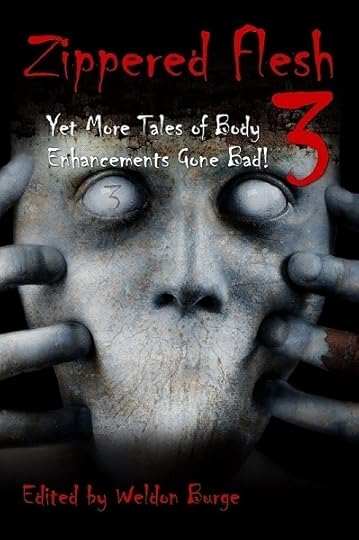
January 16, 2017
Getting Closer To The Write Stuff
The Greater Lehigh Valley Group’s annual writers conference, The Write Stuff, is just over two months away. The conference will take place March 23-25 at the Best Western Hotel in Bethlehem, PA.
Our keynote speaker will be Michael Hauge. Michael is a story and script consultant, author, and lecturer who works with writers and filmmakers on screenplays, novels, movies, and television projects. He has coached writers, producers, stars and directors for every major film studio and network. Read Michael’s interview on the Write Stuff Conference blog.
Kathryn Craft will be conducting workshops on Friday and Saturday of our conference. Kathryn writes stories that seek beauty and meaning at the edge of darkness. Rich with material for further thought or discussion, her novels make a great choice for book clubs. Long a leader in the southeastern Pennsylvania writing scene, Kathryn served for more than a decade in a variety of positions on the boards of the Greater Lehigh Valley Writers Group and the Philadelphia Writers’ Conference, and volunteers as time allows with the Women’s Fiction Writers Association. Read more about Kathryn’s workshops on the Write Stuff Conference blog.
From the self-publishing side, Jamie Saloff speaks and coaches would-be authors helping them avoid the scams and money traps many fall prey to as they endeavor to self-publish a book. She shares insider secrets that separate the amateurs from the pros. She shows clients how to keep costs low and profits high, while stressing the importance of quality and professionalism. Read more about Jamie’s Friday and Saturday conference presentations on our conference blog.
Deborah Riley-Magnus—author of fiction and non-fiction, focuses on helping authors by teaching them how to bridge the gap between the creative writer and the marketing author. As an Author Success Coach, she produces several pieces monthly for various websites and online publications. Deborah teaches online and live workshops, clinics, and boot camps. She writes an author marketing industry blog and coaches authors, one-on-one, for sales success. Read more about her Friday and Saturday workshops on our conference blog.
As an Associate Agent and Author, Victoria Selvaggio knows firsthand that finding representation can be as hard as or even harder than becoming published. But…having a good understanding of the agent’s role, as well as your own, as the author, is just as important as advocating further, for the right agent-author relationship. Victoria will be presenting topics surrounding acquiring writers, composing the query letter, and what she’s looking for in dark, edgy novels. Get more details about Victoria’s conference presentations on the Write Stuff blog.
Look for more profiles and interviews with additional Write Stuff presenters in the coming weeks!
January 14, 2017
Book Review: Alfred Hitchcock Presents Stories My Mother Never Told Me
If my mother ever told me the stories included in this collection, half of them would have put me to sleep. After reading two excellent Twilight Zone anthologies in December, I came to this Alfred Hitchcock collection expecting stories of similar quality. Regrettably, I was underwhelmed.
Oh, there were a few gems among the 13 tales, but some, such as “Smart Sucker” by Richard Wormser and “Hostage” by Don Stanford, built up to anti-climactic endings. “Witch’s Money” by John Collier began with an interesting plot, but seemed to lose momentum and wander off.
My favorites from the collection include:
When a young woman commits suicide from a broken heart, her father decides to exact a long, slow revenge against the man responsible in “The Wall-to-Wall Grave” by Andrew Benedict.
American author Ambrose Bierce vanished in Chihuahua, Mexico in 1914. However, his final tale was found inside an unusual bottle found in the obscure village of Oxoxoco. Will “The Secret of the Bottle” by Gerald Kersch reveal the mystery of Ambrose Bierce’s final days?
Ellen Baker returned from a train ride a very different person— distant, cold, aloof. Worse, she found an unsavory new boyfriend who is prone to violence and seems to have Ellen mesmerized. Determined to protect his best friend, Eddie follows Ellen aboard another train, only discover the eerie truth about her boyfriend during “A Short Trip Home” by F. Scott Fitzgerald.
When Fred Perkins receives an invitation from wealthy socialites to join them on their next hunting expedition, his first impulse is to decline. However, his wife and friends convince him that it would be a step forward for him socially. When the big day arrives, however, Fred wishes he followed his instincts and ignored “An Invitation to the Hunt” by George Hitchcock.
Every morning before breakfast Caroline’s husband Pete is more than a bit surly, he’s literally murderous! As such, Caroline often finds herself making “Adjustments” by George Mandel.
When Robert and Janet Allison decide to remain at their country cottage during the first month of autumn instead of leaving at the end of summer as they typically do, the locals seem strangely taken aback. Worse, bizarre calamities begin to occur that make the Allisons wish they had continued to be “The Summer People” by Shirley Jackson.
Traveling through Maine on what was supposed to be a sightseeing tour, Mr. Ketchum is pulled over for speeding in the seaside hamlet of Zachary, Maine. After being detained overnight, the police take Ketchum to the judge’s house where he expects to pay his fine and finally be released, until he learns a horrible truth at the hands of “The Children of Noah” by Richard Matheson.
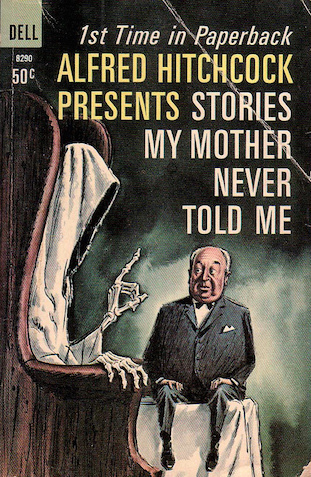
January 7, 2017
The Great Philadelphia Comic Con!
Excited to announce that I shall be returning as an author guest to the Great Philadelphia Comic Con, April 7-9 in Oaks, PA!
Once again, they have a fantastic line up of actors, artists, and writers including Colin Baker, Marina Sirtis, Bruce Boxleitner, Paul Freeman, John Wesley Shipp, JK Woodward, Tommy Castillo, Ariell Johnson, Guy Dorian, Jim Shooter, Michael Golden, Mike Zeck, and many more!
Stay tuned for more info…
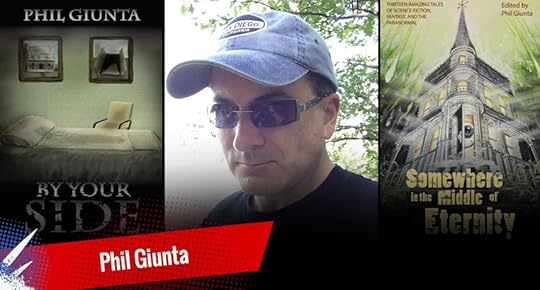
January 6, 2017
About This Writing Stuff…
Happy New Year! I hope your 2017 is off to a better and healthier start than mine. This year was less than 24 hours old when I was struck with a stomach virus that left me violently ill on and off (mostly on) for three days. At least it held off until just after the Sherlock season premiere.
It’s nice to occasionally resurrect what used to be a regular feature on my blog, this gathering of sagacious and informative articles from around the interwebs.
Although I’m not convinced that Laurie Gough’s rant against self-publishing could be labeled as either sagacious or informative. Certainly Kristen Lamb and Larry Correia don’t agree.
Over at Digital Book World, Chris Syme offers a four-step program to help authors market their books effectively on social media while Jami Gold is all about helping writers choose the best editors.
Finally, we get some perspective on POV from both Donald Maass and Chris Winkle, and Anne R. Allen explains why she writes first chapters last.
All that and a bit more. Enjoy!
Self-Publishing: An Insult to the Written Word by Laurie Gough
Author Animal Farm – New York GOOOOD, Self-Pub BAAAAD and Generation Author Snowflake & The High Cost of Instant by Kristen Lamb
Fisking the HuffPo’s Snooty Rant About Self-Publishing by Larry Correia
4 Steps to Selling More Books with Less Social Media and Why You Only Need to Sell Your Books on One Social Media Channel by Chris Syme
Spend Less Time Marketing By Setting Up Social Media Outpost Channels by Chris Syme
Picking Editors: Tips for Finding a Developmental Editor by Jami Gold
Immersive POV by Donald Maass
Choosing Your Story’s Perspective by Chris Winkle
First Chapters: Start Your Novel with Your Reader in Mind by Anne R. Allen
December 30, 2016
Book Review: Stories from the Twilight Zone by Rod Serling
As we close in on the annual New Year’s Twilight Zone marathon on the SyFy channel, I decided to delve into two collections of stories that I was fortunate enough to find in August while helping to sort donated books for my local library’s annu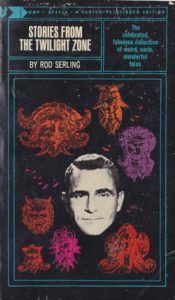 al book sale. I hope to track down more of these collections as I comb used book stores and dealer tables at conventions.
al book sale. I hope to track down more of these collections as I comb used book stores and dealer tables at conventions.
Last week, I reviewed the 1964 collection, Rod Serling’s Twilight Zone Revisited, which contains a brilliant collection of nine short stories, adapted by venerable writer and magician Walter B. Gibson, from both produced and unproduced scripts.
Stories from the Twilight Zone was published in 1960 and is, I believe, the first collection of adaptations from the series. All six of the tales in this book aired as episodes of the series and all were written by Rod Serling himself.
In “The Mighty Casey,” it’s tryout day for the foundering Brooklyn Dodgers and team manager “Mouth” McGarry is sick and tired of scraping the bottom of the barrel to find pitchers, until a tall, lean kid named Casey turns up with an unbelievable throwing arm—or perhaps inhuman might be a better description…
Hypochondriac and all around miserable wretch Bertram Beasley lives in a constant state of psychosomatic illnesses, until a mysterious old man named Cadwallader materializes with an offer of immortality. It’s soon revealed that Cadwallader is actually the devil. Nevertheless, this fact barely deters Beasely from signing the contract, which contains an “Escape Clause” should he ever decide to cancel the deal…
Advertising exec Martin Sloane is sick of the pressures and demands of corporate life in New York City. One day he decides to drive upstate and revisit his old hometown. After stopping at a gas station along the way, Martin notices that the town is within “Walking Distance.” He decides to let the gas station attendant work on his car while he finishes the rest of his journey on foot, but what he finds on the streets of his childhood is much more than nostalgia…
As a religious man of high moral standards and a precisely arranged life, Franklin Gibbs becomes quite annoyed when his timid wife wins an all-expenses-paid vacation to Las Vegas, the capital city of vice and sin. Franklin chastises his wife for dropping a nickel into a slot machine, until Franklin hears the slot machine call his name. It isn’t long before he succumbs to “The Fever.”
A young man, unable to recall his own identity, finds himself walking along a highway in parts unknown. He finally arrives in a town only to find it completely deserted, yet with signs of recent occupancy—a smoking cigar in an ashtrays and a pot of fresh boiling coffee in a diner. After days of this, the young man finds himself on the edge of sanity as he wonders, “Where is Everybody?”
“The Monsters are Due on Maple Street” when a strange object passes over a suburban neighborhood on a warm autumn Saturday. Shortly after, all utilities shut off, cars fail to start, even portable radios no longer work. As confusion sets in, 12-year old Tommy Bishop warns that it could be the work of extraterrestrials disguised as humans, just like in the comic books! The adults laugh him off at first—before violently turning on one another as strange occurrences escalate.
December 28, 2016
Hello SF Novel, My Old Friend…
With fresh eyes today, I reviewed those four chapters and remain as thrilled with them now as I was eight months ago. After some trimming and fine tuning, I’m even happier. Next step is to review the outline to refresh my memory on the story’s plot and direction. I have five days remaining in my holiday vacation, with at least two of those days carved out for writing.
I hope to finish the first draft of this novel in 2017. It’s one of my many personal goals for the year, even though I’ll be editing and project managing the third anthology in the Middle of Eternity series beginning in Q1. Oy!
For now, here’s an inspirational image that relates to the story. More news to come!

Reviewing Your Favorite Books, Even When You’re “Not Very Good At Writing”
Remember, you do not need to purchase a book from Amazon to leave a review for the book there. Also, for those unfamiliar with Goodreads, it is a social media site for book lovers where you can rate and review books, create an online library of books you currently own and would like to read, and join groups of like-minded readers to discuss your favorite books. Best of all, it’s free to join!
The screen capture below shows two Amazon reviews for Beach Nights, a collection of short stories from Cat and Mouse Press that contains my paranormal tale, “Tower Sixteen”. The book was published in October 2016.

Note the second review from Early LBI. It’s one brief sentence: “Great group of short stories.” Five words. That’s the perfect example of a brief review you can leave for any book that you enjoyed even if you’re “not very good at writing.”
Ratings and reviews help authors immensely. As our volume of reviews and ratings increases, new promotional and writing opportunities open for us, new readers notice our work, and most importantly, reader feedback encourages writers by letting us know that our work is reaching and touching people.
Thank you so much for your support! We deeply appreciate it.
December 27, 2016
Book Review: The Plague by Albert Camus
It’s the 1940s in Oran, a coastal city in the Northern African country of Algeria, when, on a spring day as random as any other, rats begin crawling out of the shadows only to die violent deaths in the streets, hotels, and other public venues.
It isn’t long before the town’s physicians, including Dr. Bernard Rieux, whose ailing wife had just departed Oran to be cared for in a sanitorium, declare that bubonic plague is upon the town during a meeting with the Prefect.
Unfortunately, it takes the rest of the population a bit longer to acknowledge the outbreak, since the plague’s attack begins slowly. Bubonic plague is the last thing anyone expects. It is not until the Prefect orders the town gates closed and all vehicular transportation terminated than panic truly sets in.
While Rieux works tirelessly to treat the victims, ultimately unable to do more than keep a tally of the ever-increasing death rate, each of his colleagues and friends reacts to the crisis differently.
Dr. Castel begins formulating an inoculation against the plague once it’s realized that the medicines sent in from Paris have no effect.
An elderly town clerk, Joseph Grand struggles with his novel-in-progress, fretting over the opening sentence for months all the while struggling with the fact that his wife, Jeanne, left him as she could no longer tolerate living in poverty. Finally, Grand volunteers to assist with plague prevention.
The mysterious Cottard, a man of “independent means”, attempts to commit suicide at the onset of the plague, but is stopped by his neighbor, Grand. Cottard has a deep distrust of the police, but comes to find that while they are distracted by the plague, his seedy activities can continue unchecked.
Young journalist Raymond Rambert is only visiting Oran for a story when the town is quarantined and will go to any lengths to escape and return to his wife. When all legal means are exhausted, he turns to Cottard in desperation.
Father Paneloux, pastor of the town’s Catholic church, believes that the plague is God’s punishment and delivers a sermon to that effect, but eventually has a change of heart, stating that God will also offer succor and mercy. He then volunteers to assist Rieux with caring for the sick and is witness to the violent death of Magistrate Othon’s son.
Jean Tarrou, who quickly becomes Rieux’s closest friend, arrived in Oran just weeks before the plague erupted and decides to form teams of sanitation workers on a volunteer basis to fight the plague. Eventually, he reveals his life story to Rieux as a way of explaining why he is fiercely determined to help people when lives are at stake.
Other characters come in and out of the narrative, but the question is whether the efforts of this core team can bring an end to a plague that ravages Oran over the course of nearly a full year. The general atmosphere and attitude of the town is brilliantly depicted as the plague escalates through the seasons.
The Plague was Camus’s first book published after WWII. Contemporary readers unfamiliar with Camus—or with works written in this era—will most certainly cringe at pages of dense background information that would, in today’s termi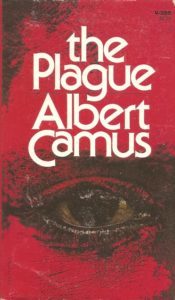 nology, be considered “infodumps.” There are also the occasional archaic sentence structures and words (a few even sent me to the dictionary) and outdated expressions of the time.
nology, be considered “infodumps.” There are also the occasional archaic sentence structures and words (a few even sent me to the dictionary) and outdated expressions of the time.
However, as I tend to gravitate toward classics, this style of prose is no stranger to me and is to be expected. It does nothing to diminish the enjoyment of such stories, but instead offers a glimpse into the history and evolution of literature.



